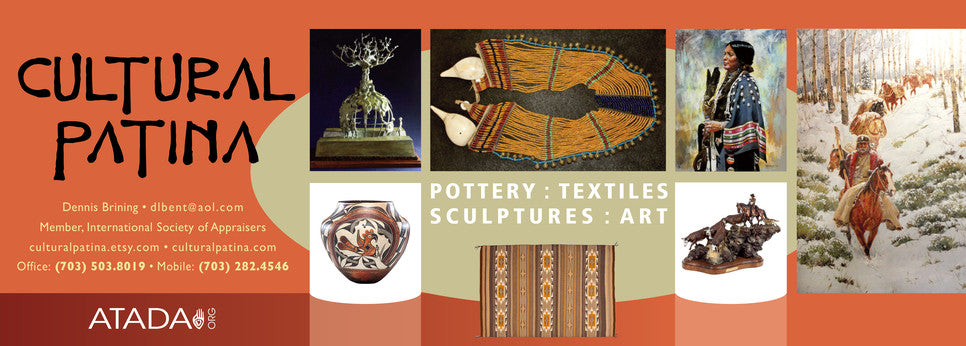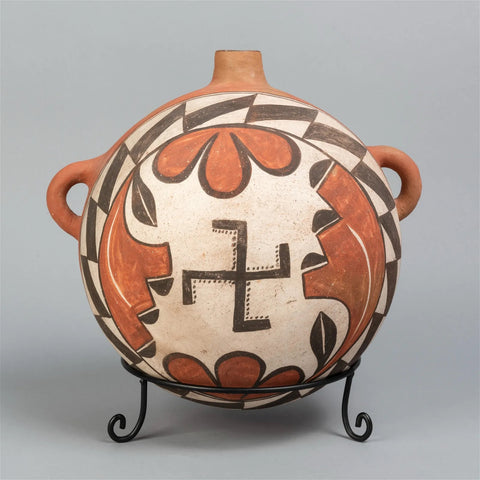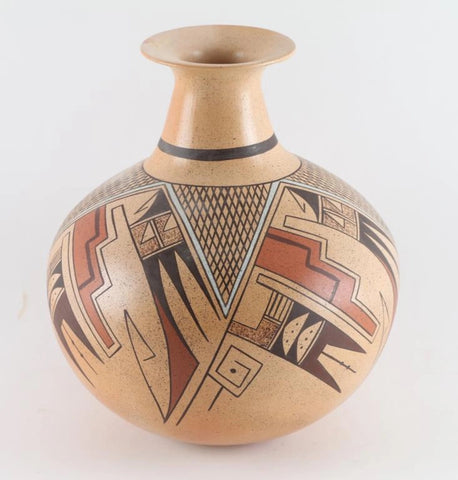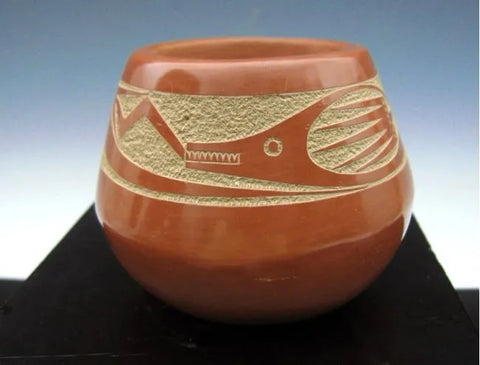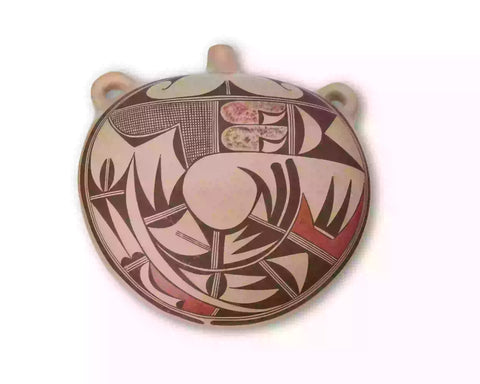
Native American, Vintage Acoma Polychrome Pottery Bowl, by Dolores Lewis, Ca 1990's, #1517
$ 1,250.00
Native American, Vintage Acoma Polychrome Pottery Bowl, by Dolores Lewis, Ca 1990's, #1517
Description: #1517 Native American, Vintage Acoma Polychrome Pottery Bowl, by Dolores Lewis, Ca 1990's. Hand coiled and painted heart line deer design signed Dolores Lewis.
Dimensions: 4'' x 6''
Condition: Very god for age.
Dolores Lewis was born in 1938 into the Acoma Sky City Pueblo. She is one of the daughters of the world renowned late, Lucy M. Lewis.
Dolores has been around great pottery artists her whole life, however, her greatest inspiration came down from her mother, Lucy. Dolores was a self taught artisan, she learned the ancient traditional methods of working with clay by carefully observing Lucy construct her beautiful pottery vessels.
Dolores chose to continue the long lived tradition of working with pottery, and using the ancient methods passed down to her from her grandmothers because of the importance to keep her peoples traditions alive. Dolores gathers her own natural pigments and clays from the clay pits within the Acoma Pueblo. She cleans her clay for impurities by hand, then, she hand mixes, hand coils, hand paints, and uses a traditional firing method to add the finishing touch to her wonderful masterpieces which mother earth has blessed her with.
The Lewis family keeps the same patterns and does not move to a contemporary style because it is very important to them to keep alive true traditions and designs of the ancient mimbres people alive. Some of these designs which are replicated are the deer with a heartline, lightning bolt pattern, and the many variations of the mimbres patterns. Lucy was the driving force behind the revival of pottery making as an art in the Pueblo of the Acoma. Dolores is also related to Emma Lewis-Mitchell, Carmel Lewis (sisters), and Drew Lewis (brother). Source: Material Insight)
Publications:
There are many books on Lucy M. Lewis and her daughters, information on these fine artisans can be found in:
-Southern Pueblo Pottery 2,000 Artist Biographies
-Fourteen Families in pueblo pottery
-Southwestern pottery Anasazi to Zuni
-Talking with the Clay
-American Indian Pottery 2nd Edition
-Seven Families in Pueblo Pottery
Awards:
-Santa Fe Indian Market Various 1st, 2nd, and 3rd Place numerous years
-Eight Northern 1st various years
-Heard Museum show
-New Mexico State Fair
-Others received too many to list
“Pueblo pottery is made using a coiled technique that came into northern Arizona and New Mexico from the south, some 1500 years ago. In the four-corners region of the US, nineteen pueblos and villages have historically produced pottery. Although each of these pueblos use similar traditional methods of coiling, shaping, finishing and firing, the pottery from each is distinctive. Various clay's gathered from each pueblo’s local sources produce pottery colors that range from buff to earthy yellows, oranges, and reds, as well as black. Fired pots are sometimes left plain and other times decorated—most frequently with paint and occasionally with applique. Painted designs vary from pueblo to pueblo, yet share an ancient iconography based on abstract representations of clouds, rain, feathers, birds, plants, animals and other natural world features.
Tempering materials and paints, also from natural sources, contribute further to the distinctiveness of each pueblo’s pottery. Some paints are derived from plants, others from minerals. Before firing, potters in some pueblos apply a light colored slip to their pottery, which creates a bright background for painted designs or simply a lighter color plain ware vessel. Designs are painted on before firing, traditionally with a brush fashioned from yucca fiber.
Different combinations of paint color, clay color, and slips are characteristic of different pueblos. Among them are black on cream, black on buff, black on red, dark brown and dark red on white (as found in Zuni pottery), matte red on red, and polychrome—a number of natural colors on one vessel (most typically associated with Hopi). Pueblo potters also produce undecorated polished black ware, black on black ware, and carved red and carved black wares.
Making pueblo pottery is a time-consuming effort that includes gathering and preparing the clay, building and shaping the coiled pot, gathering plants to make the colored dyes, constructing yucca brushes, and, often, making a clay slip. While some Pueblo artists fire in kilns, most still fire in the traditional way in an outside fire pit, covering their vessels with large potsherds and dried sheep dung. Pottery is left to bake for many hours, producing a high-fired result.
Today, Pueblo potters continue to honor this centuries-old tradition of hand-coiled pottery production, yet value the need for contemporary artistic expression as well. They continue to improve their style, methods and designs, often combining traditional and contemporary techniques to create striking new works of art.” (Source: Museum of Northern Arizona)
Description: #1517 Native American, Vintage Acoma Polychrome Pottery Bowl, by Dolores Lewis, Ca 1990's. Hand coiled and painted heart line deer design signed Dolores Lewis.
Dimensions: 4'' x 6''
Condition: Very god for age.
Dolores Lewis was born in 1938 into the Acoma Sky City Pueblo. She is one of the daughters of the world renowned late, Lucy M. Lewis.
Dolores has been around great pottery artists her whole life, however, her greatest inspiration came down from her mother, Lucy. Dolores was a self taught artisan, she learned the ancient traditional methods of working with clay by carefully observing Lucy construct her beautiful pottery vessels.
Dolores chose to continue the long lived tradition of working with pottery, and using the ancient methods passed down to her from her grandmothers because of the importance to keep her peoples traditions alive. Dolores gathers her own natural pigments and clays from the clay pits within the Acoma Pueblo. She cleans her clay for impurities by hand, then, she hand mixes, hand coils, hand paints, and uses a traditional firing method to add the finishing touch to her wonderful masterpieces which mother earth has blessed her with.
The Lewis family keeps the same patterns and does not move to a contemporary style because it is very important to them to keep alive true traditions and designs of the ancient mimbres people alive. Some of these designs which are replicated are the deer with a heartline, lightning bolt pattern, and the many variations of the mimbres patterns. Lucy was the driving force behind the revival of pottery making as an art in the Pueblo of the Acoma. Dolores is also related to Emma Lewis-Mitchell, Carmel Lewis (sisters), and Drew Lewis (brother). Source: Material Insight)
Publications:
There are many books on Lucy M. Lewis and her daughters, information on these fine artisans can be found in:
-Southern Pueblo Pottery 2,000 Artist Biographies
-Fourteen Families in pueblo pottery
-Southwestern pottery Anasazi to Zuni
-Talking with the Clay
-American Indian Pottery 2nd Edition
-Seven Families in Pueblo Pottery
Awards:
-Santa Fe Indian Market Various 1st, 2nd, and 3rd Place numerous years
-Eight Northern 1st various years
-Heard Museum show
-New Mexico State Fair
-Others received too many to list
“Pueblo pottery is made using a coiled technique that came into northern Arizona and New Mexico from the south, some 1500 years ago. In the four-corners region of the US, nineteen pueblos and villages have historically produced pottery. Although each of these pueblos use similar traditional methods of coiling, shaping, finishing and firing, the pottery from each is distinctive. Various clay's gathered from each pueblo’s local sources produce pottery colors that range from buff to earthy yellows, oranges, and reds, as well as black. Fired pots are sometimes left plain and other times decorated—most frequently with paint and occasionally with applique. Painted designs vary from pueblo to pueblo, yet share an ancient iconography based on abstract representations of clouds, rain, feathers, birds, plants, animals and other natural world features.
Tempering materials and paints, also from natural sources, contribute further to the distinctiveness of each pueblo’s pottery. Some paints are derived from plants, others from minerals. Before firing, potters in some pueblos apply a light colored slip to their pottery, which creates a bright background for painted designs or simply a lighter color plain ware vessel. Designs are painted on before firing, traditionally with a brush fashioned from yucca fiber.
Different combinations of paint color, clay color, and slips are characteristic of different pueblos. Among them are black on cream, black on buff, black on red, dark brown and dark red on white (as found in Zuni pottery), matte red on red, and polychrome—a number of natural colors on one vessel (most typically associated with Hopi). Pueblo potters also produce undecorated polished black ware, black on black ware, and carved red and carved black wares.
Making pueblo pottery is a time-consuming effort that includes gathering and preparing the clay, building and shaping the coiled pot, gathering plants to make the colored dyes, constructing yucca brushes, and, often, making a clay slip. While some Pueblo artists fire in kilns, most still fire in the traditional way in an outside fire pit, covering their vessels with large potsherds and dried sheep dung. Pottery is left to bake for many hours, producing a high-fired result.
Today, Pueblo potters continue to honor this centuries-old tradition of hand-coiled pottery production, yet value the need for contemporary artistic expression as well. They continue to improve their style, methods and designs, often combining traditional and contemporary techniques to create striking new works of art.” (Source: Museum of Northern Arizona)
Related Products
Sold out
